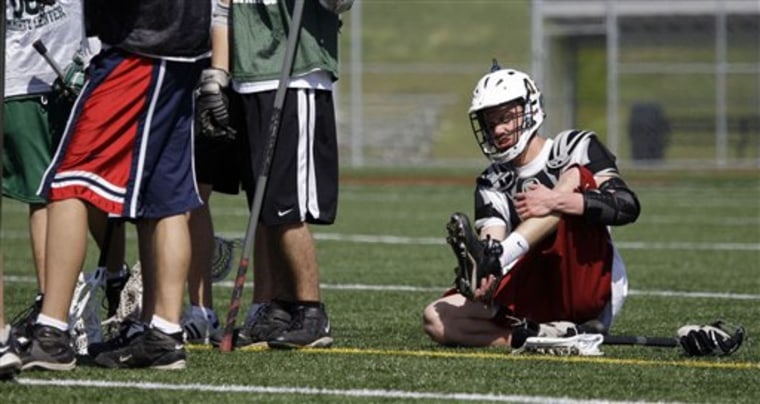Soccer dad Mike Miller prefers the smooth, cushioned surface of synthetic turf because his 13-year-old daughter can play year-round, even in the long rainy season that closes Seattle's grass fields.
But as Caty Miller and her teammates dribble, pass and shoot, their cleats kick up tiny bits of the ground-up rubber tires that are used as filler between the blades of artificial grass.
That has some health experts, activists and parents from Seattle to Chicago to Stamford, Mass. worried that children may be exposed to chemicals if they inhale or swallow the rubber granules, known as crumb rubber. Some are calling for a moratorium until the issue is more fully studied.
"Rubber tires are made with chemicals that are known carcinogens. The question remains, does that raise the risk for cancer for children? We don't know that," said Dr. Susan Buchanan, associate director of Great Lakes Center for Children's Environmental Health and an assistant professor of public health at the University of Illinois at Chicago.
Artificial turf is often made of fake blades of grass with sand or ground tires used as fill to provide a springy cushion. About 25 million used auto tires are recycled into turf each year, according to Synthetic Turf Council, the Atlanta-based trade group. About 4,500 synthetic turf fields are in use throughout the country.
Some doing their own health studies
Supporters say the artificial turf encourages increased outdoor play, reduces water and herbicide use and provides an even, predictable surface that's more cushioned than old-style AstroTurf.
Playing fields with artificial turf "drain well. They don't get as muddy. The ball bounces a little higher, goes a little faster," Miller said.
But potential health concerns have led Connecticut and California to conduct their own studies on the health effects of turf. New York City health officials recently commissioned a study to evaluate air quality above synthetic turf and found it didn't show appreciable effects from contaminants in the rubber.
"The crumb rubber that's used in many fills are safe," said Shira Miller, a spokeswoman for the Synthetic Turf Council.
But Dr. Philip Landrigan, professor and chairman of community and preventive medicine at Mount Sinai School of Medicine in New York, still wants a moratorium until more thorough studies are done.
Some studies in the U.S. and Europe have assessed potential exposure and health risks for people using turf and concluded that health effects are unlikely.
But Landrigan said he's aware of no studies that have evaluated how the chemicals affect actual children who play on turf field containing crumb rubber.
"All those toxins are very available to kids, if kids are playing and running," he said. "All this chemical soup is going to get on their skins and their fingers."
Recycled tires contain chemicals
Recycled tires contain metals such as zinc, plus toxic chemicals such as benzene and butadiene and polycyclic aromatic hydrocarbons, which also are contained in exhaust, smoke and soot.
Crumb rubber also is used for solid playground and track surfaces, but because it's in the form of a mat, there's less concern the rubber can get into kids, Landrigan said.
Heat also is a concern, raising the possibility of heat stress or heat stroke; temperatures on artificial turf fields have been recorded at 130 to 140 degrees, Landrigan said.
Last year, the U.S. Consumer Product Safety Commission investigated lead in artificial turf after New Jersey health officials found high lead content in some fields. The CPSC said none of the fields tested at levels that would be harmful to children, but it called for voluntary standards to eliminate lead in future products.
Seattle is adding six new synthetic turf fields in the next year after reviewing current research on health or environmental risks.
The fields cost more to install than grass — about $800,000 each — but save in maintenance costs and reduced herbicide and fertilizer use, said Dewey Potter, a Seattle parks spokeswoman.
Sports boosters say artificial turf allows more games to be played in the months when Seattle's trademark rain closes grass fields and pushes sports onto hated dirt and sand fields.
"We love natural grass, but it doesn't work for year-round and really intensive use," said Bill Farmer, a board member of Seattle's Friends of Athletic Fields.
Larger debate over fields
The health concerns also have become part of a larger debate over whether the fields are a good idea in general. Some object to spending taxpayer money, and others simply prefer natural open space.
"Why have parks if you're going to pave them? They should be grass fields," said Chris Van Dyk, who led an unsuccessful attempt to block artificial turf fields on Washington's Bainbridge Island, just west of Seattle. He said he doesn't want his sons playing on it.
In San Francisco last summer, health officials reviewed the available literature and found there wasn't enough evidence of risks from lead, bacteria or crumb rubber to warrant tearing up and replacing existing fields. But they said that where possible the city should consider alternatives such as turf that uses cork or coconut husks as fill.
On the sidelines of a Seattle scrimmage, soccer mom Beatriz Salgado said her daughter prefers grass because the artificial turf can get too hot during the summer.
"In the summer, you can really smell it. It smells like tar," she said. "I would like to know more about what's in it."
